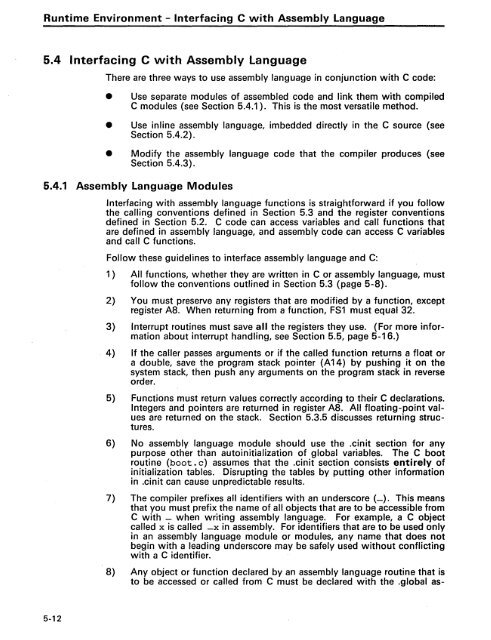TMS34010 C Compiler - Al Kossow's Bitsavers
TMS34010 C Compiler - Al Kossow's Bitsavers
TMS34010 C Compiler - Al Kossow's Bitsavers
You also want an ePaper? Increase the reach of your titles
YUMPU automatically turns print PDFs into web optimized ePapers that Google loves.
Runtime Environment - Interfacing C with Assembly Language<br />
5.4 Interfacing C with Assembly Language<br />
There are three ways to use assembly language in conjunction with C code:<br />
• Use separate modules of assembled code and link them with compiled<br />
C modules (see Section 5.4.1). This is the most versatile method.<br />
• Use in line assembly language, imbedded directly in th~ C source (see<br />
Section 5.4.2).<br />
• Modify the assembly language code that the compiler produces (see<br />
Section 5.4.3).<br />
5.4.1 Assembly Langua"ge Modules<br />
Interfacing with assembly language functions is straightforward if you follow<br />
the calling conventions defined in Section 5.3 and the register conventions<br />
defined in Section 5.2. C code can access variables and call functions that<br />
are defined in assembly language, and assembly code can access C variables<br />
and call C functions.<br />
Follow these guidelines to interface assembly language and C:<br />
1 ) <strong>Al</strong>l functions, whether they are written in C or assembly language, must<br />
follow the conventions outlined in Section 5.3 (page 5-8).<br />
2) You must preserve any registers that are modified by a function, except<br />
register A8. When returning from a function, FS1 must equal 32.<br />
3) Interrupt routines must save all the registers they use. (For more information<br />
about interrupt handling, see Section 5.5, page 5-16.)<br />
4) If the caller passes arguments or if the called function returns a float or<br />
a double, save the program stack pointer (A14) by pushing it on the<br />
system stack, then push any arguments on the program stack in reverse<br />
order.<br />
5) Functions must return values correctly according to their C declarations.<br />
Integers and pointers are returned in register A8. <strong>Al</strong>l floating-point values<br />
are returned on the stack. Section 5.3.5 discusses returning structures.<br />
6) No assembly language module should use the .cinit section for any<br />
purpose other than autoinitialization of global variables. The C boot<br />
routine (boot. c) assumes that the .cinit section consists entirely of<br />
initialization tables. Disrupting the tables by putting other information<br />
in .cinit can cause unpredictable results.<br />
7) The compiler prefixes all identifiers with an underscore (_). This means<br />
that you must prefix the name of all objects that are to be accessible from<br />
C with - when writing assembly language. For example, a C object<br />
called x is called -x in assembly. For identifiers that are to be used only<br />
in an assembly language module or modules, any name that does not<br />
begin with a leading underscore may be safely used without conflicting<br />
with a C identifier.<br />
8) Any object or function declared by an assembly language routine that is<br />
to be accessed or called from C must be declared with the .global as-<br />
5-12

















